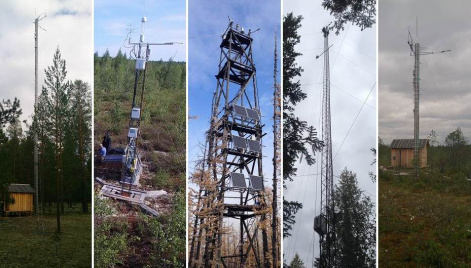Climate change will lead to rapid loss of moisture in the northern hemisphere swamps
14 May 2020 г.

The wide green belt in the north of Eurasia and North America, covering one eighth of the earth's land, is called the boreal zone. This is one of the last global natural systems which preserved its relative primordiality. The total reserves of organic carbon in boreal ecosystems exceed the amount of carbon in the Earth’s atmosphere. As a result of decomposition, the carbon accumulated in these systems enters the atmosphere in the form of carbon dioxide, a greenhouse gas which is largely responsible for maintaining the climate on the planet.
Global climate models, predicting the near future, certainly describe the behavior of boreal ecosystems. Most often, they represent this territory as a huge area of taiga. However, in addition to the endless forests in the north, there are also swarmps in large amount, occupying about 15% of the boreal zone. The available quantity of moisture is one of the key parameters for predicting the behavior of terrestrial ecosystems, namely, their absorption of atmospheric carbon. If various ecosystems of the boreal zone are distinguished by their ability to retain moisture, global models which take into account only the behavior of forests will provide inaccurate forecasts.
A team of scientists from Canada, Russia, the USA, Germany, Japan, Sweden and Finland, with the participation of scientists of the Federal Research Center “Krasnoyarsk Science Center SB RAS”, combined their data to make a global assessment of the rate of moisture release by various boreal ecosystems. The vegetation of swamps and forests turned out to be fundamentally different in their ability to retain moisture during climate change. As a result, under certain warming scenarios, in two thirds of the area of the boreal zone, bogs will lose 20% more moisture than forests.
“For several years now, at five stations of the Krasflux network in the Krasnoyarsk Region, in the vicinity of the villages Zotino, Tura and Igarka, we have been measuring the exchange of carbon and moisture between forests and swamps of Siberia and the atmosphere. At each station there are poles of different heights (from 6 to 35 m) with micrometeorological and gas-analytical equipment. Data from a few observation points on the vast territory of Siberia is our contribution to the meta-analysis carried out within the study for the entire boreal zone. The published paper includes data from 95 stations. As a result, swamps of the boreal belt are expected to lose moisture much faster than forests during climate warming. However, even the collected data were not enough to analyze the differences, for example, between swamps of different types. We would be interested in finding some regional features. This is the objective of the research for the coming years. It is extremely important both for global climate models and national environmental management to understand and predict the response of specific ecosystems to global warming, ” says one of the authors of the article, Candidate of Biological Sciences, head of the laboratory of biogeochemical cycles in forest ecosystems at the V.N. Sukacheva Institute of Forest SB RAS, Anatoly Prokushkin.
Plants produce moisture mainly in summer, due to a process called evapotranspiration. With climate warming, the air will become drier. In response, forest ecosystems, consisting mainly of vascular plants (trees, shrubs, and grasses), would reduce the amount of the released moisture, regulating the function of stomata through which plants exchange water, oxygen, and carbon dioxide with the atmosphere. Unlike vascular plants, bog mosses do not have active defense mechanisms against moisture loss. The warmer and drier the air becomes, the more moisture the swamps will lose as compared to taiga forests.
According to Manuel Helbig, the initiator and chief author of this work, as cited by the press service of McMaster University (Canada), the drainage of wetlands during warming will increase the rates of carbon decomposition of peat, resulting in higher emissions of carbon dioxide into the atmosphere and in the increase of global warming. In addition, dried swamps will not be able to fulfill their function of firebreaks while, on the contrary, they will contribute to the spread of fires. Thus, in global environmental models it is extremely important to take into account the increasing rate of moisture loss in wetland ecosystems when global temperatures rise.
The long-term efforts of the Krasnoyarsk scientists to create, launch and operate the Krasflux network of stations, which allows observing the peculiarities of the carbon cycle in Siberian and Arctic ecosystems, are supported by grants from Russian and foreign foundations. Currently, the work is supported by a grant from the Russian Foundation for Basic Research No. 18–05–60203-Arctic.
Share:
